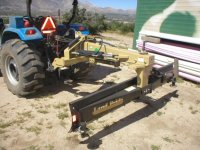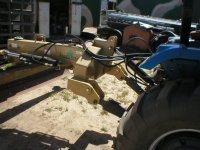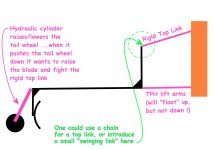MtnViewRanch
Elite Member, Advertiser
- Joined
- Mar 19, 2005
- Messages
- 10,673
- Tractor
- Mahindra 7520, Mahindra 3215HST, Case 580 extendahoe, Case 310 dozer, Parsons trencher, Cat D6,
I am a little confused.
Firstly by the picture of your grader blade in the picture above which looks huge compared to the size of your tractor, does the blade only weigh 1166 lbs (529 kg) as it says in the catalogue?
Secondly everybody has told me and what I have read is, you get the best grading result the heavier your blade is. That is why I was looking at the RBT55 at 1753 lbs (795 kg) although I think the consensus is that an 8' blade would be better than a 10' blade which was my original thinking as well. Wouldn't I be better with a heavier blade provided the tractor can handle it?
At the weight that you posted, your tractor is not going to be heavy enough to warrant the 55 series blade in my opinion. Converting my 12,000lb tractor over it weighs 5454 kg. You posted that your tractor is going to weigh 4010 kg or 8822lbs. At that total weight I would not even get the 45 series blade, but the 40 series. That is why I asked you if you were going to ballast the tractor. If you are, then go with the RBT45108. Forget about the 10' blade, the tractor will not handle it well at all. The problem with an 8 footer is that it is to narrow when the blade is angled over, that is why I keep suggesting the 9 footer. Yes the weight is a good thing, but you should look at reality and the tractor just does not warrant the 55 series in my opinion. You can get the 55 series, it won't hurt other than in the wallet. There is no 8 foot 55 series blade, it is either 9' or 10'.
Here's a couple of other pics, don't know if they give a better perspective or not.




